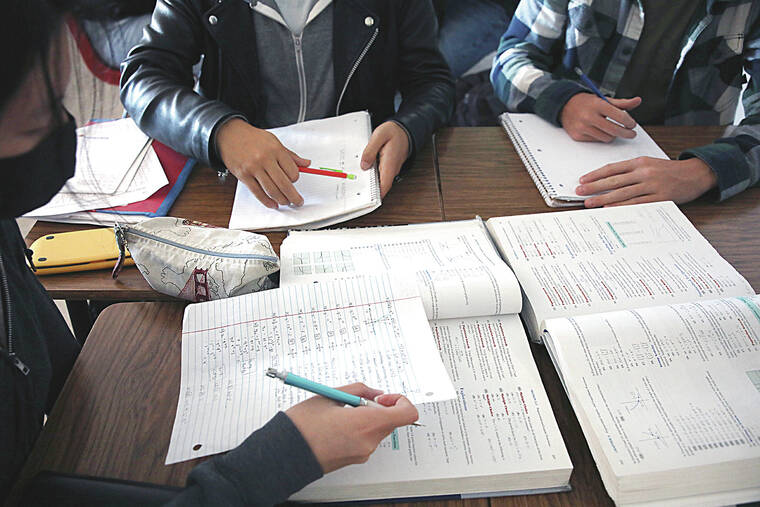The pandemic is not the only reason US students are losing ground
There was once a time when America’s lowest-performing students were improving just as much as the country’s top students.
Despite their low scores, these students at the bottom made slow but steady gains on national tests for much of the 2000s. It was one sign that the U.S. education system was working, perhaps not spectacularly, but at least enough to help struggling students keep pace with the gains of the most privileged and successful.
ADVERTISING
Today, the country’s lowest-scoring students are in free fall.
The reason is not just the pandemic. For at least a decade, starting around 2013, students in the bottom quartile have been losing ground on the National Assessment of Educational Progress, a key exam that tests a national sample of fourth and eighth grade students in math and reading.
The bottom quartile is made up of students from various backgrounds, but it includes a higher proportion of students with disabilities, students learning English and children from poor families. Since the pandemic, their scores have often continued to fall, even as high achieving students stabilize.
“Whatever is happening to the lower performers is still happening,” said Nat Malkus, a senior fellow at the American Enterprise Institute, a right-leaning think tank, who has tracked the trend.
Researchers point to a number of educational and societal changes over the past decade, including a retrenchment in school accountability, the lasting effects of the Great Recession and the rise of smartphones, which has coincided with worsening cognitive abilities even among adults since the early 2010s.
Figuring out what has happened to the lowest performers is critical, not just for their futures, but for the country’s success.
By leaving behind a huge swath of students, the United States is preparing fewer citizens to do the most technical and high-paying jobs, said Jason Dougal, who studies effective school systems at the National Center on Education and the Economy.
That only widens income inequality in the labor market, he said. And it pushes the United States further from top countries on education — places such as Singapore, Japan and Ireland — which succeed not just by raising scores for their top performers, but by lifting up their lowest students.
“To get high average performance, you can’t allow a significant portion of your population to be performing at low levels,” Dougal said.
Since the early 2010s, the United States has taken in more immigrants, which means more students learning English have entered public schools. Schools are also serving more students with disabilities.
Those demographic shifts could help explain some change in scores. Both groups are more likely to score below their peers on standardized tests. But it is most likely not the biggest factor, experts said.
The increases are small as a share of the total public school population.
And since 2013, almost every student category has seen significant declines among low performers, said Chad Aldeman, an education researcher and columnist for The 74, a nonprofit news site, who has written about the phenomenon.
The declines have sometimes been greater for more advantaged groups.
For example, in eighth grade math, the bottom 10% of proficient English speakers lost more ground than the lowest-scoring English learners, Aldeman found. Similarly, his analysis showed that the lowest-scoring students who did not have a disability fell more than the lowest-scoring students who did. The bottom scoring middle- and higher-income students lost more ground than the bottom low-income students.
This suggests that there is something about being a low-achieving student, regardless of background, that is driving the trend.
One possible explanation is the end of No Child Left Behind, the contentious school accountability law President George W. Bush signed in 2002.
The law is perhaps best known for its legacy of standardized testing, including annual exams in math and reading in third through eighth grade.
But it also put a sharp focus on low performers, part of Bush’s campaign against what he called “the soft bigotry of low expectations” in public schools. The law set a goal of having all students reach proficiency. Schools were required to break out testing data by race, income and special education status, and schools that did not show progress could face penalties.
It corresponded with a period of rapid improvement in test scores, particularly in math. Reading scores also improved, though more modestly.
The biggest increases were for students at the bottom.
But the law was also deeply unpopular on the left and the right.
Critics argued it was too punitive, with unrealistic goals. Many said it led a “drill and kill” culture of teaching to the test, leaving less time for other important subjects such as social studies and the arts.
School policies are most likely only part of the picture.
Adults have also been struggling with literacy since 2012, not only in the United States but also in other countries, according to an international survey of 16- to 65-year-olds.
The declines were driven by adults in the bottom tier of literacy, a shift that could not be explained by demographic trends, said Andreas Schleicher, director for education and skills at the Organization for Economic Co-operation and Development, which manages the survey.
© 2025 The New York Times Company





